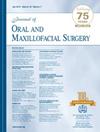Five-Year Experience With Routine Use of Intraoperative Cone-Beam Computed Tomography in Zygomaticomaxillary Complex Fractures
IF 2.3
3区 医学
Q2 DENTISTRY, ORAL SURGERY & MEDICINE
引用次数: 0
Abstract
Background
Intraoperative cone-beam computed tomography (CBCT) during open reduction and internal fixation of zygomaticomaxillary complex (ZMC) fractures may facilitate the re-establishment of a complex 3-dimensional anatomy.
Purpose
This study was conducted to measure the occurrence of malpositions after ZMC fracture reduction and intraoperative revision rates after conducting intraoperative CBCT.
Study design, setting, sample
This retrospective case series included subjects treated for ZMC fractures with intraoperative CBCT at the Department of Maxillofacial Surgery of the University Hospital Zurich (Switzerland) over a 5-year period (January 2015 to December 2019). The exclusion criteria were a history of facial fracture and incomplete data.
Predictor variable
Not applicable.
Main outcome variables
The primary outcome variable was malpositioning after ZMC fracture reduction on intraoperative 3-dimensional imaging. Further variables—including intraoperative revisions of ZMC malpositions, osteosynthesis material revisions, and intraoperative assessments of orbital reconstruction—were analyzed.
Covariates
Demographic (age and sex) and clinical (associated with facial fractures) characteristics were assessed.
Analyses
The analyses included Spearman's rank correlations, mosaic plots, χ2 tests, and Fisher's exact tests. The confidence level for hypothesis testing was set at P < .05.
Results
The sample included 337 subjects, and 589 intraoperative CBCT scans were obtained. ZMC malposition after reduction was observed in 154 (45.7%) subjects; the most common malpositions were caudal displacement, underprojection, and inward rotation of the ZMC. Intraoperative revisions were conducted in 150 (44.5%) subjects: 105 (31.2%) subjects exhibited a ZMC malposition, 13 (3.9%) subjects needed revisions of the osteosynthesis material placement, and 32 (9.5%) subjects required intraoperative orbital floor reconstruction. No secondary revision surgeries were required, excluding 25 secondary orbital floor reconstructions. Preoperative and intraoperative radiographic findings did not correlate regarding indications for orbital floor reconstruction.
Conclusion and relevance
The 44.5% intraoperative revision rate underscores the challenges of ZMC fracture surgery. Clinical evaluation of fracture reduction at the latero-orbital rim is recommended to identify caudal displacements, and intraoperative CBCT helps identify candidates for primary orbital floor reconstruction. This technique may enhance quality control and precision, thereby potentially improving patient outcomes.
术中常规应用锥形束计算机断层扫描治疗颧颌复合体骨折的5年经验。
背景:术中锥形束计算机断层扫描(CBCT)在切开复位和内固定颧腋复合体(ZMC)骨折可以促进重建复杂的三维解剖结构。目的:本研究测量ZMC骨折复位后的错位发生率及术中行CBCT后的术中矫正率。研究设计、环境、样本:本回顾性病例系列包括瑞士苏黎世大学医院颌面外科5年(2015年1月至2019年12月)接受术中CBCT治疗的ZMC骨折患者。排除标准为面部骨折史和资料不完整。预测变量:不适用。主要结局变量:术中三维成像显示ZMC骨折复位后定位错位为主要结局变量。进一步的变量-包括术中修正的ZMC错位,骨合成材料修正,和术中评估眼眶重建-进行了分析。协变量:评估人口统计学(年龄和性别)和临床(与面部骨折相关)特征。分析:分析包括Spearman秩相关、马赛克图、χ2检验和Fisher精确检验。假设检验的置信水平设为P < 0.05。结果:共纳入337例受试者,获得术中CBCT扫描589张。复位后出现ZMC错位154例(45.7%);最常见的错位是尾端移位、下凸和ZMC向内旋转。150例(44.5%)患者进行了术中修复,105例(31.2%)患者出现ZMC错位,13例(3.9%)患者需要修复植骨材料放置,32例(9.5%)患者需要术中眶底重建。除25例二次眶底重建外,无二次翻修手术。术前和术中CBCT结果与眶底重建的指征无关。结论及意义:44.5%的术中翻修率凸显了ZMC骨折手术的挑战。建议对眶后缘骨折复位进行临床评估,以确定尾侧移位,术中CBCT有助于确定初级眶底重建的候选者。这项技术可以提高质量控制和精度,从而潜在地改善患者的治疗效果。
本文章由计算机程序翻译,如有差异,请以英文原文为准。
求助全文
约1分钟内获得全文
求助全文
来源期刊

Journal of Oral and Maxillofacial Surgery
医学-牙科与口腔外科
CiteScore
4.00
自引率
5.30%
发文量
0
审稿时长
41 days
期刊介绍:
This monthly journal offers comprehensive coverage of new techniques, important developments and innovative ideas in oral and maxillofacial surgery. Practice-applicable articles help develop the methods used to handle dentoalveolar surgery, facial injuries and deformities, TMJ disorders, oral cancer, jaw reconstruction, anesthesia and analgesia. The journal also includes specifics on new instruments and diagnostic equipment and modern therapeutic drugs and devices. Journal of Oral and Maxillofacial Surgery is recommended for first or priority subscription by the Dental Section of the Medical Library Association.
 求助内容:
求助内容: 应助结果提醒方式:
应助结果提醒方式:


